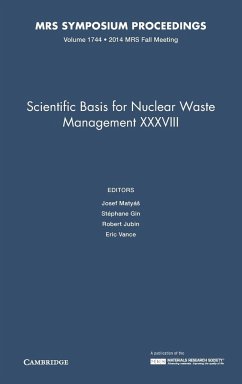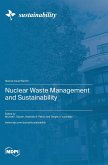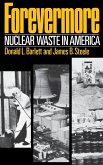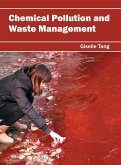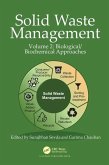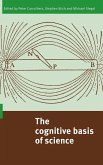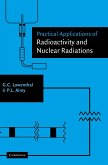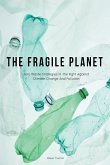Scientific Basis for Nuclear Waste Management XXXVIII
Herausgeber: Gin, Stéphane; Matyá¿, Josef; Jubin, Robert
Scientific Basis for Nuclear Waste Management XXXVIII
Herausgeber: Gin, Stéphane; Matyá¿, Josef; Jubin, Robert
- Gebundenes Buch
- Merkliste
- Auf die Merkliste
- Bewerten Bewerten
- Teilen
- Produkt teilen
- Produkterinnerung
- Produkterinnerung
Symposium EE, entitled 'Scientific Basis for Nuclear Waste Management XXXVIII', was held from 30 November to 5 December 2014, at the MRS Fall Meeting in Boston.
Andere Kunden interessierten sich auch für
![Nuclear Waste Management and Sustainability Nuclear Waste Management and Sustainability]() Nuclear Waste Management and Sustainability111,99 €
Nuclear Waste Management and Sustainability111,99 €![Forevermore, Nuclear Waste in America Forevermore, Nuclear Waste in America]() Donald L. BarlettForevermore, Nuclear Waste in America22,99 €
Donald L. BarlettForevermore, Nuclear Waste in America22,99 €![Chemical Pollution and Waste Management Chemical Pollution and Waste Management]() Chemical Pollution and Waste Management153,99 €
Chemical Pollution and Waste Management153,99 €![Solid Waste Management Solid Waste Management]() Solid Waste Management237,99 €
Solid Waste Management237,99 €![The Cognitive Basis of Science The Cognitive Basis of Science]() Peter Carruthers / Stephen Stich / Michael Siegal (eds.)The Cognitive Basis of Science134,99 €
Peter Carruthers / Stephen Stich / Michael Siegal (eds.)The Cognitive Basis of Science134,99 €![Practical Applications of Radioactivity and Nuclear Radiations Practical Applications of Radioactivity and Nuclear Radiations]() Gerhart LowenthalPractical Applications of Radioactivity and Nuclear Radiations179,99 €
Gerhart LowenthalPractical Applications of Radioactivity and Nuclear Radiations179,99 €![The Fragile Planet Zero Waste Strategies in The Fight Against Climate Change And Pollution The Fragile Planet Zero Waste Strategies in The Fight Against Climate Change And Pollution]() Davis TrumanThe Fragile Planet Zero Waste Strategies in The Fight Against Climate Change And Pollution15,99 €
Davis TrumanThe Fragile Planet Zero Waste Strategies in The Fight Against Climate Change And Pollution15,99 €-
-
-
Symposium EE, entitled 'Scientific Basis for Nuclear Waste Management XXXVIII', was held from 30 November to 5 December 2014, at the MRS Fall Meeting in Boston.
Hinweis: Dieser Artikel kann nur an eine deutsche Lieferadresse ausgeliefert werden.
Hinweis: Dieser Artikel kann nur an eine deutsche Lieferadresse ausgeliefert werden.
Produktdetails
- Produktdetails
- Verlag: Cambridge University Press
- Seitenzahl: 260
- Erscheinungstermin: 21. Januar 2016
- Englisch
- Abmessung: 235mm x 157mm x 19mm
- Gewicht: 532g
- ISBN-13: 9781605117218
- ISBN-10: 1605117218
- Artikelnr.: 44270612
- Herstellerkennzeichnung
- Books on Demand GmbH
- In de Tarpen 42
- 22848 Norderstedt
- info@bod.de
- 040 53433511
- Verlag: Cambridge University Press
- Seitenzahl: 260
- Erscheinungstermin: 21. Januar 2016
- Englisch
- Abmessung: 235mm x 157mm x 19mm
- Gewicht: 532g
- ISBN-13: 9781605117218
- ISBN-10: 1605117218
- Artikelnr.: 44270612
- Herstellerkennzeichnung
- Books on Demand GmbH
- In de Tarpen 42
- 22848 Norderstedt
- info@bod.de
- 040 53433511
Part I. Capture and Immobilization of Radionuclides: 1. Current status of
immobilization techniques for geological disposal of radioactive iodine in
Japan; 2. French studies on the development of potential conditioning
matrices for iodine 129; 3. Effects of hydrosulfide and pH on iodine
release from an alumina matrix solid confining silver iodide; 4. Evaluation
of sorption behavior of iodide ions on calcium silicate hydrate and
hydrotalcite; 5. Study of the release of the fission gases (Xe and Kr) and
the fission products (Cs and I) under anoxic conditions in bicarbonate
water; 6. Technetium getters to improve cast stone performance; 7.
Selective ordering of pertechnetate at the interface between amorphous
silica and water: a Poisson Boltzmann treatment; Part II. Development and
Characterization of Waste Forms: 8. Pressureless sintering of sodalite
waste-forms for the immobilization of pyroprocessing wastes; 9. MoO3
incorporation in alkaline earth aluminosilicate glasses; 10. Valence and
local environment of molybdenum in aluminophosphate glasses for
immobilization of high level waste from uranium-graphite reactor spent
nuclear fuel reprocessing; 11. Copper valence and local environment in
aluminophosphate glass-ceramics for immobilization of high level waste from
uranium-graphite reactor spent nuclear fuel reprocessing; 12. Nepheline
crystallization in high-alumina high-level waste glass; 13. Wet chemical
and UV-Vis spectrometric iron speciation in quenched low and intermediate
level nuclear waste glasses; 14. A sampling method for semi-quantitative
and quantitative electron microprobe analysis of glass surfaces; 15. The
void fraction of melter feed during nuclear waste glass vitrification; 16.
Charge compensation in trivalent doped Ca3(SiO4)Cl2; 17. Effect of
charge-balancing species on Sm3+ incorporation in calcium vanadinite; Part
III. Corrosion Behavior of Materials: 18. Key phenomena governing HLW glass
behavior in the French deep geological disposal; 19. Glass corrosion in the
presence of iron-bearing materials and potential corrosion suppressors; 20.
Uncertainty in the surface area of crushed glass in rate calculations; 21.
About U(t) form of pH-dependence of glass corrosion rates at zero surface
to volume ratio; 22. Glass degradation in performance assessment models;
23. Hierarchical modeling of HLW glass-gel-solution systems for stage 3
glass degradation; 24. Solution composition effects on the dissolution of a
CeO2 analogue for UO2 and ThO2 nuclear fuels; Part IV. Storage and Disposal
of Nuclear Waste: 25. Deep borehole disposal research: what have we learned
from numerical modeling and what can we learn?; 26. Characteristics of
cementitious paste for use in deep borehole disposal of spent fuel and high
level wasteforms; 27. Physicochemical properties of vitrified forms for
LILW generated from Korean nuclear power plant; 28. Release of 108Ag from
irradiated PWR control rod absorbers under deep repository conditions; 29.
Advancing the modelling environment for the safety assessment of the
Swedish LILW repository at Forsmark; 30. Analysis of radionuclide migration
with consideration of spatial and temporal change of migration parameters
due to uplift and denudation; 31. Pore and mineral structure of rock using
nano-tomographic imaging.
immobilization techniques for geological disposal of radioactive iodine in
Japan; 2. French studies on the development of potential conditioning
matrices for iodine 129; 3. Effects of hydrosulfide and pH on iodine
release from an alumina matrix solid confining silver iodide; 4. Evaluation
of sorption behavior of iodide ions on calcium silicate hydrate and
hydrotalcite; 5. Study of the release of the fission gases (Xe and Kr) and
the fission products (Cs and I) under anoxic conditions in bicarbonate
water; 6. Technetium getters to improve cast stone performance; 7.
Selective ordering of pertechnetate at the interface between amorphous
silica and water: a Poisson Boltzmann treatment; Part II. Development and
Characterization of Waste Forms: 8. Pressureless sintering of sodalite
waste-forms for the immobilization of pyroprocessing wastes; 9. MoO3
incorporation in alkaline earth aluminosilicate glasses; 10. Valence and
local environment of molybdenum in aluminophosphate glasses for
immobilization of high level waste from uranium-graphite reactor spent
nuclear fuel reprocessing; 11. Copper valence and local environment in
aluminophosphate glass-ceramics for immobilization of high level waste from
uranium-graphite reactor spent nuclear fuel reprocessing; 12. Nepheline
crystallization in high-alumina high-level waste glass; 13. Wet chemical
and UV-Vis spectrometric iron speciation in quenched low and intermediate
level nuclear waste glasses; 14. A sampling method for semi-quantitative
and quantitative electron microprobe analysis of glass surfaces; 15. The
void fraction of melter feed during nuclear waste glass vitrification; 16.
Charge compensation in trivalent doped Ca3(SiO4)Cl2; 17. Effect of
charge-balancing species on Sm3+ incorporation in calcium vanadinite; Part
III. Corrosion Behavior of Materials: 18. Key phenomena governing HLW glass
behavior in the French deep geological disposal; 19. Glass corrosion in the
presence of iron-bearing materials and potential corrosion suppressors; 20.
Uncertainty in the surface area of crushed glass in rate calculations; 21.
About U(t) form of pH-dependence of glass corrosion rates at zero surface
to volume ratio; 22. Glass degradation in performance assessment models;
23. Hierarchical modeling of HLW glass-gel-solution systems for stage 3
glass degradation; 24. Solution composition effects on the dissolution of a
CeO2 analogue for UO2 and ThO2 nuclear fuels; Part IV. Storage and Disposal
of Nuclear Waste: 25. Deep borehole disposal research: what have we learned
from numerical modeling and what can we learn?; 26. Characteristics of
cementitious paste for use in deep borehole disposal of spent fuel and high
level wasteforms; 27. Physicochemical properties of vitrified forms for
LILW generated from Korean nuclear power plant; 28. Release of 108Ag from
irradiated PWR control rod absorbers under deep repository conditions; 29.
Advancing the modelling environment for the safety assessment of the
Swedish LILW repository at Forsmark; 30. Analysis of radionuclide migration
with consideration of spatial and temporal change of migration parameters
due to uplift and denudation; 31. Pore and mineral structure of rock using
nano-tomographic imaging.
Part I. Capture and Immobilization of Radionuclides: 1. Current status of
immobilization techniques for geological disposal of radioactive iodine in
Japan; 2. French studies on the development of potential conditioning
matrices for iodine 129; 3. Effects of hydrosulfide and pH on iodine
release from an alumina matrix solid confining silver iodide; 4. Evaluation
of sorption behavior of iodide ions on calcium silicate hydrate and
hydrotalcite; 5. Study of the release of the fission gases (Xe and Kr) and
the fission products (Cs and I) under anoxic conditions in bicarbonate
water; 6. Technetium getters to improve cast stone performance; 7.
Selective ordering of pertechnetate at the interface between amorphous
silica and water: a Poisson Boltzmann treatment; Part II. Development and
Characterization of Waste Forms: 8. Pressureless sintering of sodalite
waste-forms for the immobilization of pyroprocessing wastes; 9. MoO3
incorporation in alkaline earth aluminosilicate glasses; 10. Valence and
local environment of molybdenum in aluminophosphate glasses for
immobilization of high level waste from uranium-graphite reactor spent
nuclear fuel reprocessing; 11. Copper valence and local environment in
aluminophosphate glass-ceramics for immobilization of high level waste from
uranium-graphite reactor spent nuclear fuel reprocessing; 12. Nepheline
crystallization in high-alumina high-level waste glass; 13. Wet chemical
and UV-Vis spectrometric iron speciation in quenched low and intermediate
level nuclear waste glasses; 14. A sampling method for semi-quantitative
and quantitative electron microprobe analysis of glass surfaces; 15. The
void fraction of melter feed during nuclear waste glass vitrification; 16.
Charge compensation in trivalent doped Ca3(SiO4)Cl2; 17. Effect of
charge-balancing species on Sm3+ incorporation in calcium vanadinite; Part
III. Corrosion Behavior of Materials: 18. Key phenomena governing HLW glass
behavior in the French deep geological disposal; 19. Glass corrosion in the
presence of iron-bearing materials and potential corrosion suppressors; 20.
Uncertainty in the surface area of crushed glass in rate calculations; 21.
About U(t) form of pH-dependence of glass corrosion rates at zero surface
to volume ratio; 22. Glass degradation in performance assessment models;
23. Hierarchical modeling of HLW glass-gel-solution systems for stage 3
glass degradation; 24. Solution composition effects on the dissolution of a
CeO2 analogue for UO2 and ThO2 nuclear fuels; Part IV. Storage and Disposal
of Nuclear Waste: 25. Deep borehole disposal research: what have we learned
from numerical modeling and what can we learn?; 26. Characteristics of
cementitious paste for use in deep borehole disposal of spent fuel and high
level wasteforms; 27. Physicochemical properties of vitrified forms for
LILW generated from Korean nuclear power plant; 28. Release of 108Ag from
irradiated PWR control rod absorbers under deep repository conditions; 29.
Advancing the modelling environment for the safety assessment of the
Swedish LILW repository at Forsmark; 30. Analysis of radionuclide migration
with consideration of spatial and temporal change of migration parameters
due to uplift and denudation; 31. Pore and mineral structure of rock using
nano-tomographic imaging.
immobilization techniques for geological disposal of radioactive iodine in
Japan; 2. French studies on the development of potential conditioning
matrices for iodine 129; 3. Effects of hydrosulfide and pH on iodine
release from an alumina matrix solid confining silver iodide; 4. Evaluation
of sorption behavior of iodide ions on calcium silicate hydrate and
hydrotalcite; 5. Study of the release of the fission gases (Xe and Kr) and
the fission products (Cs and I) under anoxic conditions in bicarbonate
water; 6. Technetium getters to improve cast stone performance; 7.
Selective ordering of pertechnetate at the interface between amorphous
silica and water: a Poisson Boltzmann treatment; Part II. Development and
Characterization of Waste Forms: 8. Pressureless sintering of sodalite
waste-forms for the immobilization of pyroprocessing wastes; 9. MoO3
incorporation in alkaline earth aluminosilicate glasses; 10. Valence and
local environment of molybdenum in aluminophosphate glasses for
immobilization of high level waste from uranium-graphite reactor spent
nuclear fuel reprocessing; 11. Copper valence and local environment in
aluminophosphate glass-ceramics for immobilization of high level waste from
uranium-graphite reactor spent nuclear fuel reprocessing; 12. Nepheline
crystallization in high-alumina high-level waste glass; 13. Wet chemical
and UV-Vis spectrometric iron speciation in quenched low and intermediate
level nuclear waste glasses; 14. A sampling method for semi-quantitative
and quantitative electron microprobe analysis of glass surfaces; 15. The
void fraction of melter feed during nuclear waste glass vitrification; 16.
Charge compensation in trivalent doped Ca3(SiO4)Cl2; 17. Effect of
charge-balancing species on Sm3+ incorporation in calcium vanadinite; Part
III. Corrosion Behavior of Materials: 18. Key phenomena governing HLW glass
behavior in the French deep geological disposal; 19. Glass corrosion in the
presence of iron-bearing materials and potential corrosion suppressors; 20.
Uncertainty in the surface area of crushed glass in rate calculations; 21.
About U(t) form of pH-dependence of glass corrosion rates at zero surface
to volume ratio; 22. Glass degradation in performance assessment models;
23. Hierarchical modeling of HLW glass-gel-solution systems for stage 3
glass degradation; 24. Solution composition effects on the dissolution of a
CeO2 analogue for UO2 and ThO2 nuclear fuels; Part IV. Storage and Disposal
of Nuclear Waste: 25. Deep borehole disposal research: what have we learned
from numerical modeling and what can we learn?; 26. Characteristics of
cementitious paste for use in deep borehole disposal of spent fuel and high
level wasteforms; 27. Physicochemical properties of vitrified forms for
LILW generated from Korean nuclear power plant; 28. Release of 108Ag from
irradiated PWR control rod absorbers under deep repository conditions; 29.
Advancing the modelling environment for the safety assessment of the
Swedish LILW repository at Forsmark; 30. Analysis of radionuclide migration
with consideration of spatial and temporal change of migration parameters
due to uplift and denudation; 31. Pore and mineral structure of rock using
nano-tomographic imaging.

